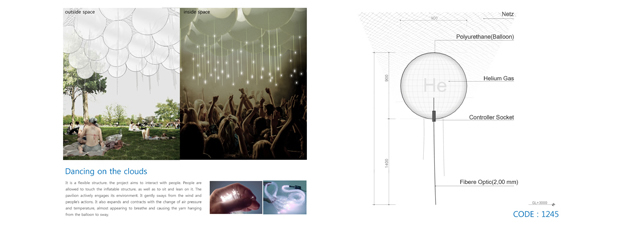Source: Philips Lumec
Dancing on the clouds, brought to us by Hyunje Joo, who is originally from Korea and now studies in Germany, was awarded second prize for his project that actively engages its environment by changing shapes with the climate and the people around. It was deemed by our jury as being very poetic and it helps in bringing people together. There is an interesting relationship between the object and the user. It is a very good interface between the sky and the ground.
First, congratulations on winning the second prize for Edition 01 of the CLUE Competition.
Tell me about yourself, your career and your education.
My name is Hyunje Joo and I am 30 years old. I graduated with a Bachelor’s degree in Architecture from Korea and I have worked in an architectural design office in both South Korea and Japan. Currently I’m studying for a Master in Architecture at the Kunstakademie (Arts Academy) in Duesseldorf.
 |
|
Korean lighting designer Hyunji Joo. (All photos courtesy of Philips) |
Where does your interest in lighting design come from?
I think that lighting is very important in a building and in our lives. In the future it might bring even more value to them. For this reason, I am always interested in lighting design.
Why did you choose to participate in the Interface themed CLUE Competition?
First, the word ‘interface’ was interesting to me. Beyond the boundaries of space, I wanted to experiment with this project.
Can you share with us your initial idea behind this concept of Dancing on the clouds and what is the interface aspect of this project?
Dancing on the clouds is a flexible structure. The project aims to interact with people. People are allowed to touch the inflatable structure, as well as to sit and lean on it. The pavilion actively engages its environment. It gently sways from the wind and people’s actions. It also expands and contracts with the change of air pressure and temperature, almost appearing to breathe and causing the yarn (fiber optic) hanging from the balloon to sway.
 |
|
Dancing on the Clouds design concept. People can interact with the floating lights. |
Do you think that your proposal could become a reality?
This project is architecture in the air. It also finds a practical and sustainable solution to temporary construction. It is completely opposite to conventional architecture. This project does not require a thick foundation.
What were your motivations for Dancing on the clouds?
People cannot touch clouds with their hands, but they can see and feel the clouds. My motivations for Dancing on the clouds started from there.
 |
|
Dancing on the Clouds design concept and diagram. |
Please tell us more about the operational aspect of your installation. How does it work?
The installation is composed of air, polyurethane, fiber optic. The balloon is filled with Helium gas and it works with the control socket. In making the shade outdoors, it produces light indoors, such as the Milky Way under the soft lighting. And it is interactive, they move and breathe with people. For this reason it is a temporary installation that has good mobility since it can be moved easily. It is not necessary to have foundation.
How do you see lighting design evolving on a long-term basis?
The future of lighting design will have to consider the integration of natural and artificial lighting techniques. All lighting should become sustainable solutions. Also it should be interacting with people.
How do you see your professional career evolving?
I want to constantly be challenged to learn by the works of others. By participating in various competitions, I want to learn new ways of thinking that offer different perspectives. It will help me to grow and develop in my field as well.














